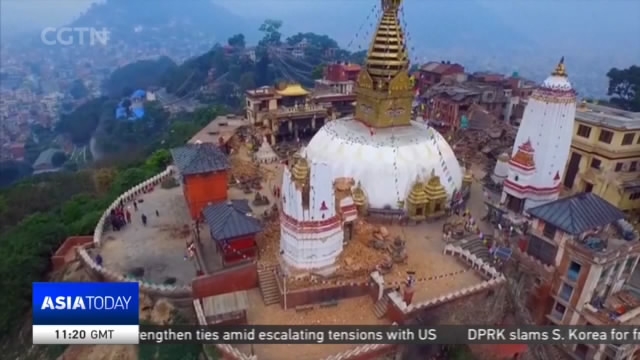
19:42, 23-Nov-2017
Spiritual Bridge: Nepal Buddhist school meditates on ties with China

In this installment of our series, we visit Nepal. Religious and medical exchanges between China and Nepal have a very long history. Our Ge Yunfei has visited the birthplace of Buddha -- Lumbini -- as well as a medical school to find out how these exchanges are bringing the two countries closer together.
In a small centuries-old monastery hidden in downtown Kathmandu, Prof. Naresh Man is working on the ritual for the morning chanting. The scripture of the Heart Sutra, written in Sanskrit, is over one-thousand years old. Prof. Naresh Man is a monk from Lumbini, the birthplace of Buddha. As the vice chancellor of the Lumbini Buddhist University, and the President of the Nepal Traditional Buddhist Association, Naresh Man has been promoting Buddhism exchanges between China and Nepal for years.
NARESH MAN BAJRACHARYA, VICE CHANCELLOR LUMBINI BUDDHIST UNIVERSITY "Buddhism can play a vital role to bring the people of China and people of Nepal together and close, and work with collaboration. There are many hopes and many scopes to globalize the Buddhism."
The great earthquake in 2015 demolished and damaged many ancient temples in Nepal. After that, hundreds of millions of renminbi from China were donated to repair those relics. Though China and Nepal's Buddhism exchanges go back thousands of years, Naresh Man admitted that the current level of communication between the two sides is very limited. He hopes his university could play a more important role in this, especially when China's Belt & Road Initiative aims to strengthen connections between the two countries.
NARESH MAN BAJRACHARYA, VICE CHANCELLOR LUMBINI BUDDHIST UNIVERSITY "First, I think if China could help to develop the Lumbini University physically and academically, that would be one great contribution. Secondly, Chinese people, they can come and join our university. Chinese scholars also, they can visit and teach in the university. And on the other hand, Chinese students and monks can join our university and they can learn in Buddhism not only in Nepal but also in the birthplace of Buddha."
The past two decades of miraculous economic growth in China is creating the world's biggest middle class. And more Chinese are now turning to Buddhism, hoping to find their inner peace -- and making donations.
NARESH MAN BAJRACHARYA, VICE CHANCELLOR LUMBINI BUDDHIST UNIVERSITY "Donation is one way to get happiness, but at the same time we should understand why we are giving. Why should we give. What is the idea behind giving? What is the philosophy behind donation? So this is the most important thing. If we have commercial mind, I may give something and I may expect something from you. I may give little but I am expecting more.Once you give, you try to forget it, then it is the real giving and real donation. "
Naresh Man said roads and railways are the physical infrastructure that shorten the distances between China and Nepal, but Buddhism could be the bridge that draws our hearts closer. Ge Yunfei, CGTN, Kathmandu in Nepal.
Patan Hospital is in the suburbs of Kathmandu. It's one of the three best hospitals in the Nepali capital. Dr. Nabees Pradhan is the head of the hospital's orthopedics department. It has been 20 years since he graduated in China.
DR. NABEES MAN SINGH PRADHAN HEAD OF DEPARTMENT OF ORTHOPEDICS PATAN ACADEMY OF HEALTH SCIENCES "I went to China in 1993, when I was 19 years old. At that time, we had only one university that had a medical school in Nepal. They would only accept 20 medical students. The Chinese government provided scholarships for us. So I went to Beijing Medical University for my postgraduate studies."
Dr. Pradhan said the experience of graduating from China's top medical school made him what he is today. And there are three other doctors in his department who have studied in China. He hopes more Nepali students will be able to go to study in China.
DR. NABEES MAN SINGH PRADHAN HEAD OF DEPARTMENT OF ORTHOPEDICS PATAN ACADEMY OF HEALTH SCIENCES "From my perspective, there is a big gap in healthcare between China and Nepal. China has much higher medical standards. I hope more of our medical students will have the opportunity to study in China for masters or PhD degrees. The students' technique of operation will be improved. And also, I hope doctors from China could come to Nepal and exchange work experience with us. In this way, we could learn from the Chinese doctors."
The Arniko Society is an alumni association of scholars and experts in Nepal who have graduated from China. Its president, Sarbottam Shrestha, says his organization is the first to translate and publish documents on China's Belt & Road Initiative into Nepali. Shrestha thinks Traditional Chinese Medicine could play a bigger role in Nepal.
SARBOTTAM SHRESTHA PRESIDENT, ARNIKO SOCIETY "So far, it's totally a blank in the field of Traditional Chinese Medicine cooperation between China and Nepal. There are no Traditional Chinese Medicine hospitals. There are some TCM doctors but they only serve Chinese people here. So we want push TCM to Nepali society as a whole."
Shrestha says he hopes the Belt & Road Initiative will help the two countries establish a mutual certificate recognition system. Ge Yunfei, CGTN, Kathmandu.

SITEMAP
Copyright © 2018 CGTN. Beijing ICP prepared NO.16065310-3
Copyright © 2018 CGTN. Beijing ICP prepared NO.16065310-3